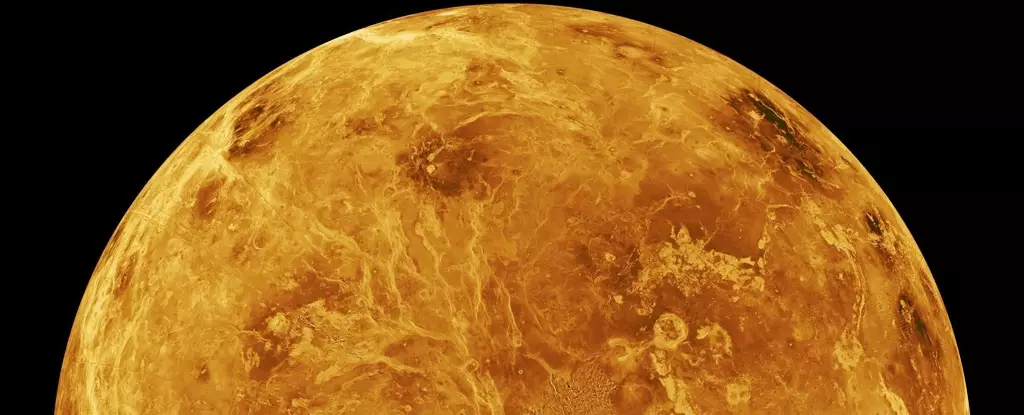In the grand narrative of our Solar System, the early years were marked by chaos and violence. As the planets formed, they were subjected to relentless bombardment by asteroids and comets, leading to a violent landscape shaped by colossal impacts. Mercury, Mars, and our Moon bear the scars of these historic collisions, showcasing craters that remind us of a turbulent past. Earth, while more hospitable today, also retains hints of its formative impacts, hidden beneath its dynamic geological processes. However, the planet Venus presents a peculiar anomaly. Despite its surface being adorned with numerous craters, scientists have long been puzzled by the absence of large impact basins, particularly those exceeding 300 kilometers across. Recent discoveries may challenge longstanding perceptions about Venus and could reshape our understanding of the planet’s geological evolution.
Venus, often characterized by its extreme conditions—sulfuric acid clouds, scorching temperatures, and crushing atmospheric pressure—has fascinated scientists for decades. Its surface is a canvas of impact craters, many of which appear remarkably preserved. Yet, the absence of larger craters, particularly those associated with significant impact events, has raised questions. How could a planet so exposed to impacts lack evidence of the colossal forces at play during its early history? This enigma has propelled researchers to delve deeper into the geology of Venus, leading to the discovery of a feature known as tessera terrain—an intriguing arrangement of concentric rings that spans approximately 1,500 kilometers across.
Recent studies have focused on the Haastte-Baad Tessera, which appears to be a larger and older impact structure than previously recognized. Geologist Vicki Hansen suggests that this feature may have formed as a result of two substantial impacts occurring in rapid succession. This theory posits that Venus, in its youth, had a molten interior beneath a fragile crust, which would have interacted dramatically with the impacts. If validated, this scenario could revolutionize our understanding of the planet’s formation and offers a rare insight into the complex processes that shaped early planetary bodies.
According to Hansen and her research team, the dynamic young Venus—with a thin crust above a partially molten mantle—would have created a unique environment for impacts. When two celestial bodies, each potentially as large as 75 kilometers across, struck the surface in quick succession, the consequences would have been profound. The initial impacts would have led to intense melting and the subsequent creation of the concentric ring structures known as tesserae. These revelations not only reshape our understanding of Venus but also invite further comparisons to similar formations observed on other celestial bodies.
To comprehend the implications of these findings, one can look to the multi-ring impact structure on Jupiter’s moon Callisto, known as Valhalla. Spanning approximately 3,800 kilometers, this vast feature was forged by a massive impact that caused the icy surface to deform under tremendous forces. The insights gained from studying Valhalla lend credence to the hypothesis surrounding Haastte-Baad Tessera. The mechanisms by which impacts lead to geometric surface formations can be complex, influenced by various factors, including the composition of the impacting bodies and the nature of the target’s crust.
In the case of Venus, it is crucial to note that the structure and thickness of the lithosphere play a significant role. Unlike Mars and the Moon, Venus may not have possessed a robust lithosphere during its formative years. This factor helps explain why researchers had previously underestimated the potential for different impact structures to emerge on Venus, resulting in an intriguing reshuffling of how scientists approach impact studies.
One of the most captivating aspects of Hansen’s research is the concept of “residuum,” a solid material that remains after partial melting. Following an impact event, the buoyant residuum can rise within the mantle, dramatically altering the terrain above it. This phenomenon creates a unique landscape, which could explain the oddly flat terrain observed in Haastte-Baad. If the magma produced during the collision remains where it forms, it solidifies into a hardened formation that elevates the surrounding landscape. Conversely, if the molten material drains away, it could lead to a subsidence effect, potentially explaining the observed trapezoidal shapes of the tesserae.
This understanding of how impact structures evolve not only aids in interpreting the geology of Venus but also inspires comparisons with Earth’s geological features. Such large-scale processes may have occurred under similar conditions, providing scientists with a broader framework for understanding planetary formation across the Solar System.
The recent advancements in our understanding of Venus highlight the need for continued exploration and research. The Haastte-Baad Tessera stands as a testament to the complexities underlying planetary formation and the dynamic interactions that shaped our celestial neighborhood. As more data is gathered, it is clear that Venus holds secrets waiting to be discovered—insights that could inform not just our knowledge of the planet but also the processes that govern all rocky worlds. As scientists continue to peel back the layers of Venusian geology, they may not only rewrite the history of our neighboring planet but also redefine our understanding of impact events throughout the cosmos.


Leave a Reply